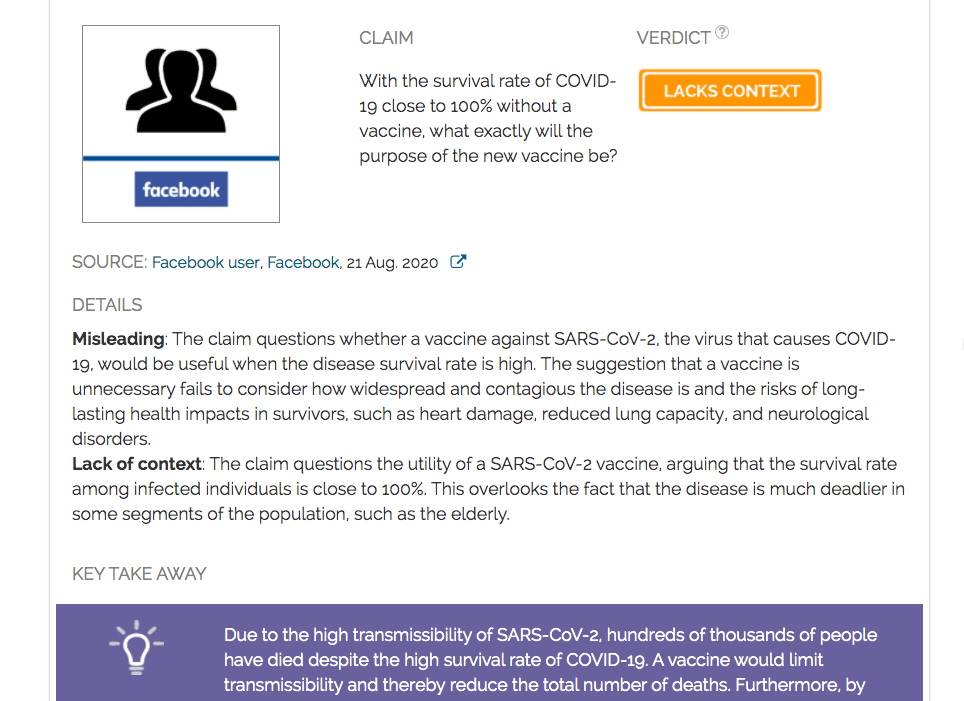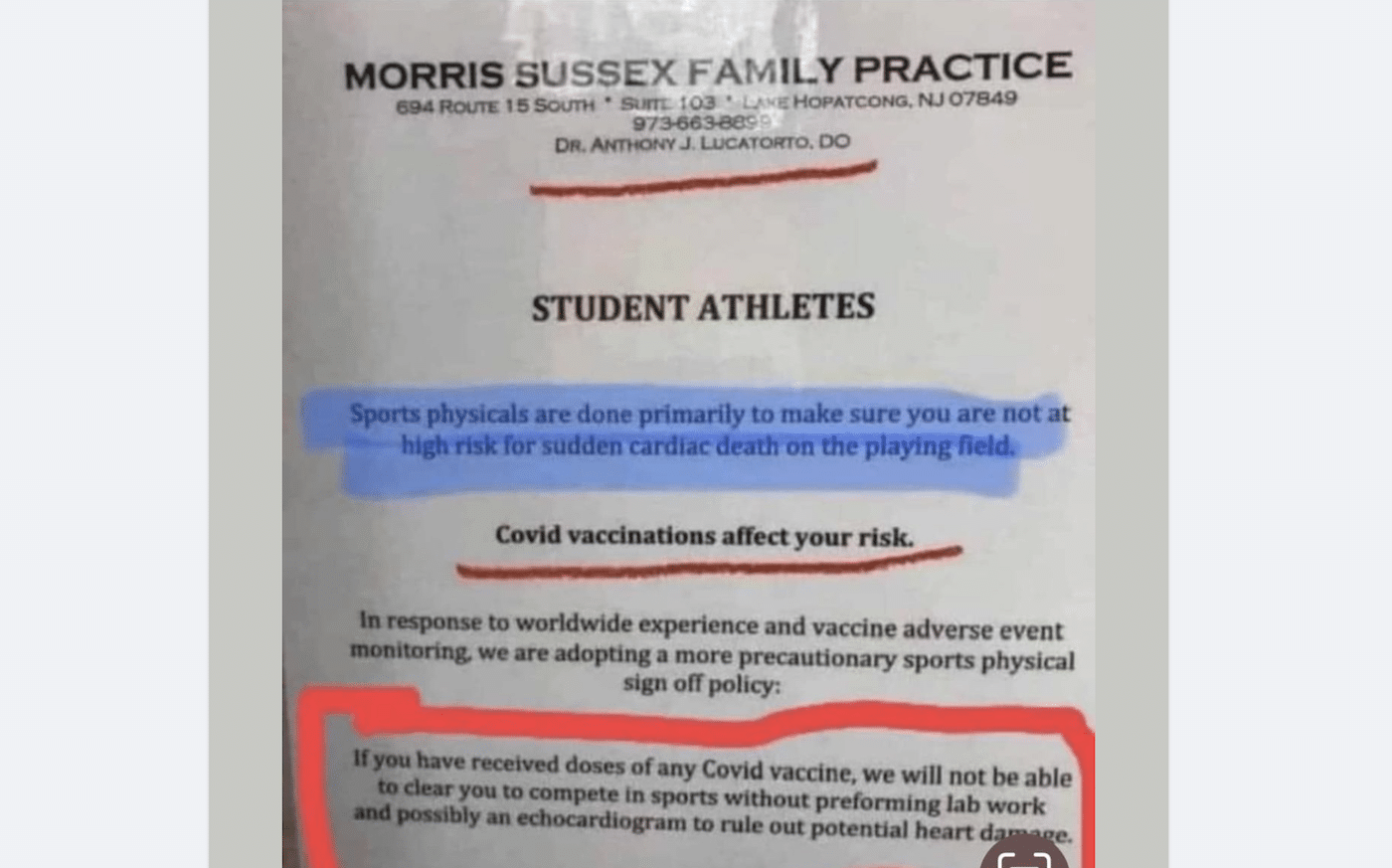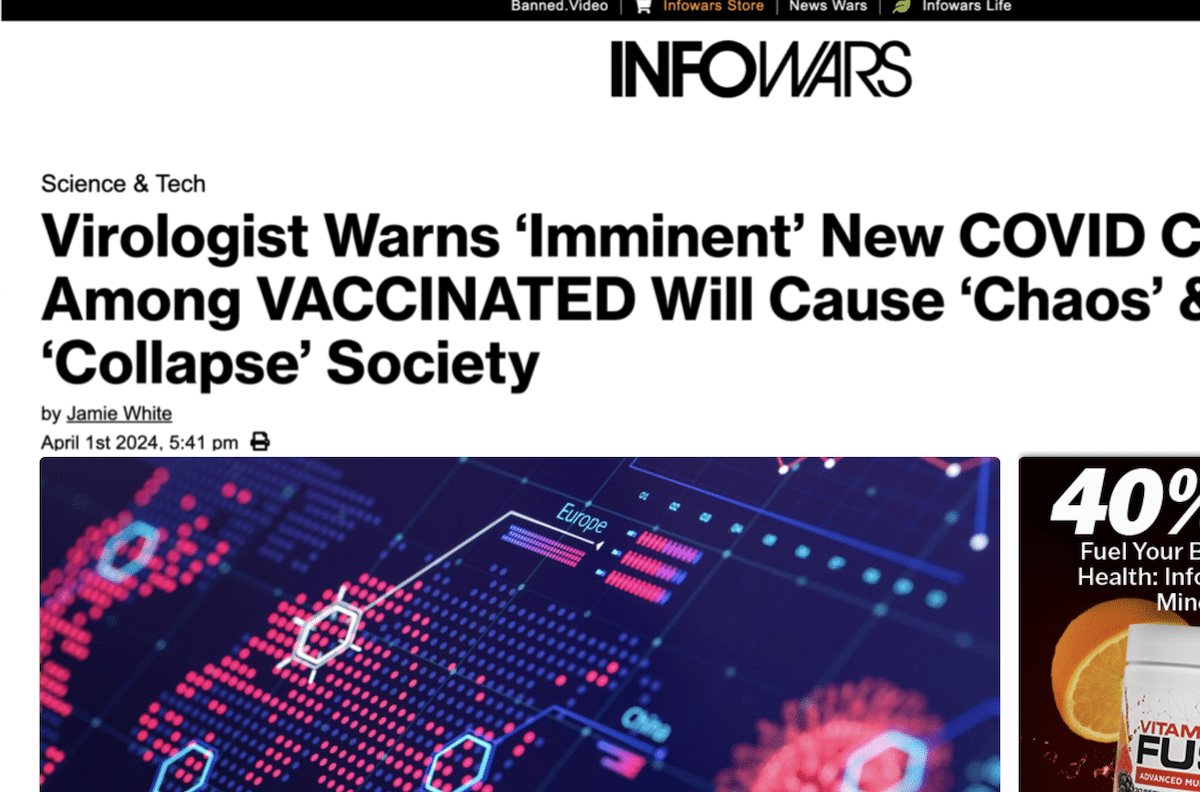- Health
A vaccine against SARS-CoV-2 would be useful even if the survival rate from COVID-19 is high
Key takeaway
Due to the high transmissibility of SARS-CoV-2, hundreds of thousands of people have died despite the high survival rate of COVID-19. A vaccine would limit transmissibility and thereby reduce the total number of deaths. Furthermore, by reducing the rate of infection or perhaps simply disease severity, a vaccine could also reduce non-lethal yet potentially permanent conditions, such as damage to the heart, lungs, and other tissues. Finally, a vaccine could slow the propagation of the virus through a population by helping to achieve herd immunity, which protects vulnerable persons such as the elderly and immunocompromised. Vaccines confer a range of important benefits, even for diseases with a high average rate of survival.
Reviewed content

Verdict:
Claim:
With the survival rate of COVID-19 close to 100% without a vaccine, what exactly will the purpose of the new vaccine be?
Verdict detail
Misleading: The claim questions whether a vaccine against SARS-CoV-2, the virus that causes COVID-19, would be useful when the disease survival rate is high. The suggestion that a vaccine is unnecessary fails to consider how widespread and contagious the disease is and the risks of long-lasting health impacts in survivors, such as heart damage, reduced lung capacity, and neurological disorders.
Lack of context: The claim questions the utility of a SARS-CoV-2 vaccine, arguing that the survival rate among infected individuals is close to 100%. This overlooks the fact that the disease is much deadlier in some segments of the population, such as the elderly.
Full Claim
With the survival rate of COVID-19 close to 100% without a vaccine, what exactly will the purpose of the new vaccine be?
Review
A misleading claim circulating on Facebook in August 2020 questions whether a vaccine against SARS-CoV-2, the virus that causes COVID-19, would be useful because the “survival rate [of COVID-19 is] close to 100% without a vaccine”. This claim is misleading because it suggests that vaccines are only useful for preventing diseases with low survival rates. The claim disregards factors besides average survival rate that are critical for evaluating the usefulness of a vaccine.
Disease survival rate alone is not sufficient for determining whether development of a vaccine would be useful because it overlooks the fact that the more people who become infected in the first place, the more who will die from the disease. Virus transmissibility is therefore an important factor to consider because it directly impacts the total number of individuals who may become infected. For instance, an extremely deadly virus with low transmissibility could end up killing fewer people than a less deadly virus that infects the entire world population.
Current estimates of the infection fatality ratio (IFR) of COVID-19, which is the number of deaths that have occurred among all people infected with SARS-CoV-2, are between 0.5% and 0.7%[1,2,3]. While an IFR of 0.5% can be interpreted as a survival rate “close to 100%”, it still means that out of 1,000 infections, 5 people could die. In other words, if the entire U.S. population of 328 million people became infected, an estimated 1.6 million would be expected to die.
SARS-CoV-2 has spread rapidly throughout the world, infecting nearly 25 million people to date, because it is transmitted through respiratory droplets from person to person. In addition, because SARS-CoV-2 is new to the human population, people have little or no preexisting immunity to the virus. These factors influence the basic reproduction number (R0), which is the average number of people that an already-infected individual will typically infect. This number provides insight into the potential transmissibility of the virus.
The reproduction number of a virus is difficult to determine as it is strongly influenced by multiple factors, including local population density, cultural practices, air temperature, and humidity. A Nature news article reported that estimates for the R0 of SARS-CoV-2 range from 2 to 2.5. Many other diseases have R0s that fall within this range, including the 1918 Spanish flu[4,5], tuberculosis, and Ebola, all of which have existing vaccines or vaccines in development. For comparison, SARS-CoV-2 is more contagious than the 2009 swine flu (R0 of 1.4 to 1.6)[6] and less contagious than smallpox (5 to 7) and measles (12 to 18).
Despite the low IFR of COVID-19, the widespread prevalence and high transmissibility of SARS-CoV-2 has caused hundreds of thousands of deaths worldwide and made it one of the leading causes of death in 2020. This is illustrated by the unusually high number of excess deaths recorded in the U.S. in 2020 compared to the average number of deaths in previous years, as Health Feedback previously reported.
The claim suggests that the average survival rate from COVID-19 is the deciding factor when determining the usefulness of a vaccine. However, diseases can also cause severe, long-term or permanent conditions, albeit not immediately life-threatening. For example, polio can cause permanent paralysis even if a patient survives. In the case of COVID-19, an April 2020 news article in Science detailed how SARS-CoV-2 damages a variety of tissues in the body, both directly and indirectly, due to inflammation[7].
Indeed, a growing number of reports indicate that COVID-19 can produce a diverse list of symptoms, some of which can significantly impair a patient’s recovery and impact quality of life. The Mayo Clinic lists heart failure, difficulty breathing, and risks of neurological disorders[8] among them. Researchers from Swansea University have also warned of potential long-lasting effects of infection, including lung damage. Therefore, SARS-CoV-2 infection does not need to be deadly in order to severely jeopardize a person’s health and quality of life. An effective vaccine could protect people from suffering potentially debilitating damage from COVID-19.
Finally, the claim that the “survival rate [is] close to 100%” is an average, and therefore overlooks the fact that the survival rate for COVID-19 is much lower for older individuals and people with pre-existing medical conditions, such as obesity, chronic kidney disease, or hypertension. The CDC reports that the mortality rate for COVID-19 is at least 30 times higher for people older than 50 years than it is for people between 18 and 29 years old. For example, a study estimated the average IFR in China to be 0.66%, but the IFR among people more than 60 years old was three times higher[2]. Based on this data, COVID-19 is much deadlier for some segments of the population than others. A vaccine could not only directly benefit the people who get it, but could also indirectly protect more vulnerable individuals in a population by helping to achieve herd immunity.
In summary, the claim questions whether a vaccine for SARS-CoV-2 would be useful based on the sole consideration that the survival rate of COVID-19 is “close to 100%”. Such reasoning is misleading as it does not take into account three important factors that make a vaccine a suitable strategy. First, a disease with a high survival rate can still cause a large number of deaths in a population, and this number increases with the proportion of the population that becomes infected. Second, death is not the only important outcome associated with diseases that can be prevented by vaccines; vaccines also reduce the incidence of long-term damage and delayed recovery. Third, the average survival rate does not capture the fact that certain segments of the population, such as the elderly, are more vulnerable to the disease than others. Hence, widespread vaccination of the population would also help protect vulnerable segments of the population from a potentially deadly infection by helping to achieve herd immunity.
REFERENCES
- 1 – Russell et al. (2020) Estimating the infection and case fatality ratio for coronavirus disease (COVID-19) using age-adjusted data from the outbreak on the Diamond Princess cruise ship, February 2020. Eurosurveillance.
- 2 – Verity et al. (2020) Estimates of the severity of coronavirus disease 2019: a model-based analysis. The Lancet Infectious Diseases.
- 3 – Salje et al. (2020) Estimating the burden of SARS-CoV-2 in France. Science.
- 4 – Andreasen et al. (2008) Epidemiologic Characterization of the 1918 Influenza Pandemic Summer Wave in Copenhagen: Implications for Pandemic Control Strategies. The Journal of Infectious Diseases.
- 5 – Petersen et al. (2020) Comparing SARS-CoV-2 with SARS-CoV and influenza pandemics. The Lancet Infectious Diseases.
- 6 – Fraser et al. (2009) Pandemic Potential of a Strain of Influenza A (H1N1): Early Findings. Science.
- 7 – Merad et al. (2020) Pathological inflammation in patients with COVID-19: a key role for monocytes and macrophages. Nature Reviews Immunology.
- 8 – Paterson et al. (2020) The emerging spectrum of COVID-19 neurology: clinical, radiological and laboratory findings. Brain.



